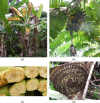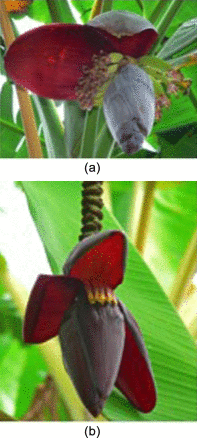Xanthomonas campestris pv. musacearum: a major constraint to banana, plantain and enset production in central and east Africa over the past decade
- PMID: 28677256
- PMCID: PMC6638165
- DOI: 10.1111/mpp.12578
Xanthomonas campestris pv. musacearum: a major constraint to banana, plantain and enset production in central and east Africa over the past decade
Abstract
Taxonomy: Bacteria; Phylum Proteobacteria; Class Gammaproteobacteria; Order Xanthomonadales; Family Xanthomonadaceae; Genus Xanthomonas; currently classified as X. campestris pv. musacearum (Xcm). However, fatty acid methyl ester analysis and genetic and genomic evidence suggest that this pathogen is X. vasicola and resides in a separate pathovar.
Isolation and detection: Xcm can be isolated on yeast extract peptone glucose agar (YPGA), cellobiose cephalexin agar and yeast extract tryptone sucrose agar (YTSA) complemented with 5-fluorouracil, cephalexin and cycloheximide to confer semi-selectivity. Xcm can also be identified using direct antigen coating enzyme-linked immunosorbent assay (DAC-ELISA), species-specific polymerase chain reaction (PCR) using GspDm primers and lateral flow devices that detect latent infections.
Host range: Causes Xanthomonas wilt on plants belonging to the Musaceae, primarily banana (Musa acuminata), plantain (M. acuminata × balbisiana) and enset (Ensete ventricosum).
Diversity: There is a high level of genetic homogeneity within Xcm, although genome sequencing has revealed two major sublineages.
Symptoms: Yellowing and wilting of leaves, premature fruit ripening and dry rot, bacterial exudate from cut stems.
Distribution: Xcm has only been found in African countries, namely Burundi, Ethiopia, Democratic Republic of the Congo, Kenya, Rwanda, Tanzania and Uganda.
Ecology and epidemiology: Xcm is transmitted by insects, bats, birds and farming implements. Long-distance dispersal of the pathogen is by the transportation of latently infected plants into new areas.
Management: The management of Xcm has relied on cultural practices that keep the pathogen population at tolerable levels. Biotechnology programmes have been successful in producing resistant banana plants. However, the deployment of such genetic material has not as yet been achieved in farmers' fields, and the sustainability of transgenic resistance remains to be addressed.
Keywords: Xanthomonas wilt; banana; enset; plantain.
© 2017 BSPP AND JOHN WILEY & SONS LTD.
Figures




References
-
- Addis, T. , Handoro, F. and Blomme, G. (2004) Bacterial wilt (Xanthomonas campestris pv. musacearum) on enset and banana in Ethiopia. InfoMusa, 13, 44–45.
-
- Addis, T. , Turyagyenda, L.F. , Alemu, T. , Karamura, E. and Blomme, G. (2010) Garden tool transmission of Xanthomonas campestris pv. musacearum on banana (Musa spp.) and enset in Ethiopia. Acta Hort. 879, 367–372.
-
- Adriko, J. , Aritua, V. , Mortensen, C.N. , Tushemereirwe, W.K. , Kubiriba, J. and Lund, O.S. (2012) Multiplex PCR for specific and robust detection of Xanthomonas campestris pv. musacearum in pure culture and infected plant material. Plant Pathol. 61, 489–497.
-
- Adriko, J. , Aritua, V. , Mortensen, C.N. , Tushemereirwe, W.K. , Mulondo, A.L. , Kubiriba, J. and Lund, O.S. (2016) Biochemical and molecular tools reveal two diverse Xanthomonas groups in bananas. Microbiol. Res. 183, 109–116. - PubMed
-
- Almaz, N. and Anke, N. (2004) The significance of enset culture and biodiversity for rural household food and livelihood security in southwestern Ethiopia. Agric. Human Values, 21, 61–71.
MeSH terms
LinkOut - more resources
Full Text Sources
Other Literature Sources
Molecular Biology Databases
Miscellaneous

